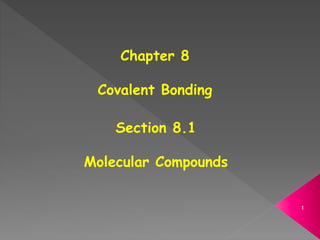
Chapter 8 sections 8.1 and 8.2 (1)
- 1. Chapter 8 Covalent Bonding Section 8.1 Molecular Compounds 1
- 2. Are HCl (hydrochloric acid) and (H2O) water ionic compounds? These compounds are not ionic, because their atoms do not give or accept electrons, they held together by sharing electrons forming a covalent bond. Some elements found in nature in the form of molecules. Molecule A neutral group of atoms joined together by covalent bonds. e.g. oxygen molecule is a diatomic molecule because it consists of two atoms joined together by a covalent bond. Diatomic molecule: is a molecule consists of two atoms. If a compound is composed of molecules is called, molecular compound. So HCl (hydrochloric acid) and H2O (water) are molecular compounds 2
- 3. Molecular compounds have lower melting and boiling points than ionic compounds. Characteristics of molecular compounds: o Low melting and boiling points. o many compounds are gases and liquids at room temperature. Molecular Formula The chemical formula of a molecular compound. It shows how many atoms of each element a molecule contains. • Write the molecular formula for water. • How many elements are there in water molecule? • How many atoms are there in water molecule? • Is water ionic or molecular compound? e.g. 3
- 4. But the molecular formula does not show the molecule’s structure. 4
- 5. 5
- 6. Section 8.2 The Nature of Covalent Bonding 6
- 7. In covalent bonds, electron sharing usually occurs so that atoms attain the electron configurations of noble gases. Single Covalent Bond is a bond joining two atoms by sharing one pair of electrons. e.g. hydrogen gas consists of diatomic molecules whose atoms share only one pair of electrons, forming a single covalent bond. An electron dot structure such as represents the shared pair of electrons of the covalent bond by two dots. H:H 7
- 8. Structural Formula represents the covalent bonds by dashes and shows the arrangement of covalently bonded atoms. All halogens form covalent single bonds in their diatomic molecules. because a halogen has seven valence electrons, so it needs one more to attain the electron configuration of a noble gas. 8
- 9. Each fluorine atom contributes one electron to complete the octet. The pair of valence electrons that is not shared between atoms is called, Unshared Pair. e.g. Fluorine atom has seven valence electrons. By sharing electrons and forming a single covalent bond, two fluorine atoms achieve the electron configuration of neon. 9
- 10. e.g. (H2O) water is a molecule containing three atoms with two single covalent bonds. Two hydrogen atoms share electrons with one oxygen atom. The hydrogen and oxygen atom attain noble-gas configurations by sharing electrons. The oxygen atom in water has two unshared pairs of valence electrons. 10
- 11. e.g. NH3 (ammonia) has 3 single covalent bonds with unshared pair of electrons. 11
- 12. e.g. CH4 (Methane) has 4 single covalent bonds with no unshared pair of electrons. 12
- 13. Double and Triple Covalent Bonds A bond formed by sharing two pairs of electrons is called, double covalent bond. 13
- 14. A bond formed by sharing three pairs of electrons is called, triple covalent bond. 14
- 15. Sometimes a molecule can not attain the octet rule by single, double or triple covalent bonds. e.g. In carbon monoxide molecule, oxygen has a stable configuration while the carbon does not. To solve this problem, oxygen donates one its unshared electrons of electrons for bonding. 15
- 16. Coordinate Covalent Bond is a covalent bond in which one atom contributes both bonding electrons. It can be shown in structural formula as an arrow that points from the atom donating the pair of electrons to the atom receiving them. In a coordinate covalent bond, the shared electron pair comes from one of the bonding atoms. 16
- 17. e.g. NH4 + (ammonium ion) consists of atoms joined by covalent bonds, including coordinate covalent bond. The ammonium ion forms when charged hydrogen ion (H+) attaches to the unshared pair of an ammonia molecule (NH3). Polyatomic ion is a tightly bound group of atoms that has a positive or negative charge and behaves as a unit. 17
- 18. Write the electron dot structure of Ozone. Notice that the structure on the left can be converted to the one on the right by shifting electron pairs without changing the positions of the oxygen atoms. The actual bonding of oxygen atoms in ozone is a hybrid, or mixture, of the extremes represented by the resonance forms. Resonance structure: is a structure that occurs when it is possible to draw two or more valid electron dot structures that have the same number of electron pairs for a molecule or ion. 18